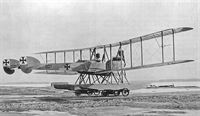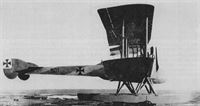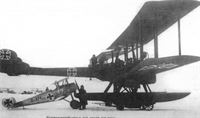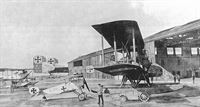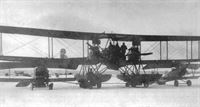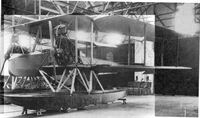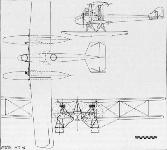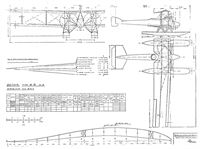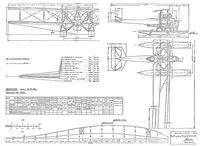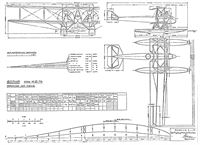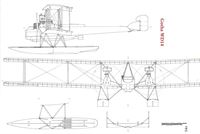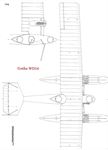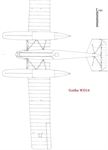
Описание
Страна: Германия
Год: 1917
Варианты
- Gotha - WD.7 - 1916 - Германия
- Gotha - WD.11 - 1917 - Германия
- Gotha - WD.14/WD.20 - 1917 - Германия
- Gotha - WD.22 - 1918 - Германия
- Gotha - WD.27 - 1918 - Германия
- В.Обухович, А.Никифоров Самолеты Первой Мировой войны
- O.Thetford, P.Gray German Aircraft of the First World War (Putnam)
- J.Herris Gotha Aircraft of WWI (A Centennial Perspective on Great War Airplanes 6)
- M.Schmeelke "Torpedo Los!" (Aeronaut)
- E.Hauke, W.Schroeder, B.Totschinger Die Flugzeuge der k.u.k. Luftfahrtruppe und Seeflieger 1914-1918
- M.Dusing German Aviation Industry in WWI. Volume 1 (A Centennial Perspective on Great War Airplanes 84)
-
M.Schmeelke - "Torpedo Los!" /Aeronaut/
Gotha WD14 #1416, August 1917 (Profile based on #1415 at Norderney, for which we have a reference photo.)
-
M.Dusing - German Aviation Industry in WWI. Volume 2 /Centennial Perspective/ (85)
The Gotha WD 14 prototype (Navy No. 801) was powered by two integral propellers and 220 hp Benz engines (1916/17).
The prototype WD14, Marine Number 801, on a beaching dolly upon delivery to the SVK on 16 January 1917. This aircraft has a rear gunner but no nose turret; the pilot and observer sat side-by-side.
Something of an all-rounder, the Gotha WD 14 is seen here in prototype form, wearing its naval serial 801. First flown in January 1917, this twin 220hp Benz Bz IV three seater was designed to fulfil the roles of torpedo bomber, minelayer, or long range reconnaissance. Top level speed was 72mph at sea level, while the range was an impressive 806 miles. Following satisfactory testing and acceptance of the prototype, a further 68 production WD 14s were delivered with the navy serials 1415-1430, 1617-1631, 1651-62 and 1946-1970. -
J.Herris - Gotha Aircraft of WWI /Centennial Perspective/ (6)
The prototype WD14, Marine Number 801, upon delivery to the SVK on 16 January 1917. As a result of trials, ailerons were added to the lower wings and the rudder area was increased to improve control with one engine out.
-
J.Herris - Gotha Aircraft of WWI /Centennial Perspective/ (6)
The prototype WD14, Marine Number 801, on a beaching dolly upon delivery to the SVK on 16 January 1917. This aircraft has a rear gunner but no nose turret; the pilot and observer sat side-by-side.
-
M.Dusing - German Aviation Industry in WWI. Volume 1 /Centennial Perspective/ (84)
Gotha WD14 (Marine No. 801).
-
M.Schmeelke - "Torpedo Los!" /Aeronaut/
The uncamouflaged Gotha WD14 prototype marine number 801. (Peter M. Grosz collection, STDB)
-
M.Schmeelke - "Torpedo Los!" /Aeronaut/
A WD14, perhaps Marine Number 1415 but the number is not legible. As a result of trials, ailerons were added to the lower wings and the rudder area was increased to improve control with one engine out.
Другие самолёты на фотографии: Euler D.I / D.II - Германия - 1916
-
J.Herris - Gotha Aircraft of WWI /Centennial Perspective/ (6)
The prototype WD14, Marine Number 801, upon delivery to the SVK on 16 January 1917. As a result of trials, ailerons were added to the lower wings and the rudder area was increased to improve control with one engine out.
Другие самолёты на фотографии: Euler D.I / D.II - Германия - 1916
-
J.Herris - Gotha Aircraft of WWI /Centennial Perspective/ (6)
Delivered on 11 July 1917, WD14, Marine Number 1415 of the second series (Marine Numbers 1415-1430) had enlarged rudders and ailerons on all wings. Originally ordered as a torpedo bomber, it was modified for long-range maritime reconnaissance now that torpedo attacks had been basically abandoned. At Norderney, #1415 was used to test wireless equipment, navigation instruments, and droppable fuel tanks, here installed in the torpedo bay. Euler D.II 274/17, a single-seat trainer, provides an interesting size comparison.
On October 2, 1917, Gotha 1415 departed Norderney on a 10-hour flight along the German North Sea coast (departure 0745, landing 1745).Другие самолёты на фотографии: Euler D.I / D.II - Германия - 1916
-
M.Dusing - German Aviation Industry in WWI. Volume 2 /Centennial Perspective/ (85)
One of four aircraft hangars for storage and repair purposes at Norderney. In front: Gotha WD14 and an Euler D.II (274/17).
Другие самолёты на фотографии: Euler D.I / D.II - Германия - 1916
-
J.Herris - Gotha Aircraft of WWI /Centennial Perspective/ (6)
Delivered on 11 July 1917, WD14, Marine Number 1415 of the second series (Marine Numbers 1415-1430) had enlarged rudders and ailerons on all wings. Originally ordered as a torpedo bomber, it was modified for long-range maritime reconnaissance now that torpedo attacks had been basically abandoned. At Norderney, #1415 was used to test wireless equipment, navigation instruments, and droppable fuel tanks, here installed in the torpedo bay. Euler D.II singleseat trainers flank it on both sides.
Другие самолёты на фотографии: Euler D.I / D.II - Германия - 1916
-
M.Schmeelke - "Torpedo Los!" /Aeronaut/
Side view of a production Gotha WD14. Marine number 1427 was touched out of the original print. (Peter M. Grosz collection, STDB)
-
M.Schmeelke - "Torpedo Los!" /Aeronaut/
Compared to the prototype, production WD14 aircraft were camouflaged with printed fabric, had a cockpit with a flexible machine gun in the nose, had larger rudders, and had ailerons on all wings. (Peter M. Grosz collection, STDB)
-
J.Herris - Gotha Aircraft of WWI /Centennial Perspective/ (6)
WD14 Marine Number 1617 of the third series was delivered in November 1917. To investigate its suitability as a reconnaissance bomber, it had a gun turret in a nose widened to hold five 10-kg bombs on each side. In place of a torpedo, ten 60-kg bombs could be carried in the torpedo bay. According to Navy records, twelve WD14s, Marine Numbers 1617-1628, were equipped for long-range reconnaissance flights of 8 1/2 hours duration and twelve WD14s, Marine Numbers 1651-1662, were equipped for torpedo attack missions of 4 hours duration.
-
M.Schmeelke - "Torpedo Los!" /Aeronaut/
The Gotha WD14 was a large floatplane designed as a torpedo bomber. Power was from two 220 hp Benz Bz.IV engines. The German Navy had decided torpedo bombers were too vulnerable to shipboard anti-aircraft fire by the time the WD14 was available and the aircraft was used for long-range maritime reconnaissance. Production aircraft were camouflaged overall with fabric printed with hexagonal shapes, despite the official late-war naval camouflage specifying this fabric on the upper surfaces only. The aircraft is MN 1617. (Peter M. Grosz collection, STDB)
-
M.Schmeelke - "Torpedo Los!" /Aeronaut/
Gotha WD 14, No. 16xx on the slipway at Sylt station in summer of 1918.
-
M.Schmeelke - "Torpedo Los!" /Aeronaut/
WD14 #1946 was the first aircraft of the last production batch. An additional central rudder was fitted to this batch to improve controllability. The batch was not completed due to the Armistice. (Peter M. Grosz collection, STDB)
-
M.Schmeelke - "Torpedo Los!" /Aeronaut/
This appears to be WD14 Marine Number 1946. This view clearly shows the additional central rudder added to the last series to improve control response. The new insignia was standardized 30 March 1918. WD14 #1946 was transferred from Warnemunde to Wiek or Bug on 2 October 1918.
A late-production Gotha WD 14 (probable Navy No. 1946) with final tail configuration was powered by two integral propellers and 220 hp Benz engines (1916/17). -
M.Schmeelke - "Torpedo Los!" /Aeronaut/
WD14 Marine Number 1946 of the last series as photographed after modification on 14 June 1918. Equipped for long-range reconnaissance with a droppable fuel tank replacing the torpedo, the additional central rudder is just visible.
-
J.Herris - Gotha Aircraft of WWI /Centennial Perspective/ (6)
The Gotha WD.14 (MN 1946 shown here) was driven by two Fliegel propellers.
WD14 Marine Number 1946 of the last series was photographed after modification on 14 June 1918. Twenty-five WD14s, Marine Numbers 1946-1970, were ordered in October 1917 equipped for long-range reconnaissance with a droppable fuel tank replacing the torpedo. For improved controllability this series had an additional central rudder. Reported "totally unsuited for the front" due to poor aileron and rudder response, the modified Marine Number 1946 is shown with balanced ailerons of increased area. Only nine WD14s of this series were accepted before the Armistice. The German naval camouflage scheme standardized in April 1917 specified three-color hexagonal camouflage on all upper surfaces, with side surfaces blue-gray and undersurfaces light gray. Despite that, photos show that production models of the Gotha WD14 wore the naval lozenge fabric overall surfaces except the floats, giving them a much darker appearance than the standard camouflage. -
M.Schmeelke - "Torpedo Los!" /Aeronaut/
The Gotha WD14 was a large floatplane designed as a torpedo bomber. Power was from two 220 hp Benz Bz.IV engines. The German Navy had decided torpedo bombers were too vulnerable to shipboard anti-aircraft fire by the time the WD14 was available and the aircraft was used for long-range maritime reconnaissance. Production aircraft were camouflaged overall with fabric printed with hexagonal shapes, despite the official late-war naval camouflage specifying this fabric on the upper surfaces only. (Peter M. Grosz collection, STDB)
-
M.Schmeelke - "Torpedo Los!" /Aeronaut/
A torpedo aircraft at the SVK at Warnemunde.
-
M.Schmeelke - "Torpedo Los!" /Aeronaut/
Seaplanes from Norderney station. A Gotha WD14 long-range reconnaissance aircraft is pictured in the background on the right side of the image.
Другие самолёты на фотографии: Friedrichshafen FF33 - Германия - 1915
-
M.Schmeelke - "Torpedo Los!" /Aeronaut/
WD14 Marine Number 1429 was transferred from Flensburg to List on 17 December 1917, but was noted as being dismantled at List on 9 March 1918.
-
M.Schmeelke - "Torpedo Los!" /Aeronaut/
Takeoff preparations for a Gotha WD.14 at List/Sylt station.
-
M.Schmeelke - "Torpedo Los!" /Aeronaut/
Production WD14 aircraft taxiing. Most production aircraft had a nose turret. The engines were mounted as tractors to keep the propellers clear of water spray. (Peter M. Grosz collection, STDB)
-
M.Schmeelke - "Torpedo Los!" /Aeronaut/
Late production Gotha WD14 in the water.
-
J.Herris - Gotha Aircraft of WWI /Centennial Perspective/ (6)
Gotha WD 20 Marine Number 1515 (of a 3-plane batch of 1515-1517) in the factory before delivery in May 1918. Derived from the WD14, the WD20s were designed to carry the larger 50cm torpedo, so power was from two 260 hp Mercedes D.IVa engines. Gotha WD 20 Marine Number 1517 had an additional, central rudder similar to that fitted to late-production WD 14s. Gotha WD 20 Marine Number 1517 had an additional, central rudder similar to that fitted to late-production WD14s. After disappointing results from torpedo attacks, the WD20s were reconfigured for long-range reconnaissance over the North Sea. The WD20 was not accepted for operational service due to poor flying characteristics; it was tail heavy, a problem plaguing the contemporary Gotha G.IV and G.V bombers.
-
M.Schmeelke - "Torpedo Los!" /Aeronaut/
WD14 cockpit with some instruments and controls labeled.
-
M.Schmeelke - "Torpedo Los!" /Aeronaut/
On March 17, 1917, Lt.z.S Scheurlen crashed in Flensburg with Gotha WD14 (801). Fortunately, Heinz Scheurlen was only slightly injured.
-
M.Schmeelke - "Torpedo Los!" /Aeronaut/
Above: Flug-Obermaat Esser and a mechanic crashed from an altitude of 25 meters on 14 Jan. 1918 during a test flight in Gotha WD.14 (1418). Both were unharmed.
Below: The bottom of the fuselage and wings on Gotha WD.14 (1418) were also covered with Navy camouflage fabric. -
M.Schmeelke - "Torpedo Los!" /Aeronaut/
Gotha WD.14 (1418) crashed at Zeebrugge on January 14, 1918.
В.Обухович, А.Никифоров Самолеты Первой Мировой войны
Дальний торпедоносец W.D. 14 был создан по техническому заданию на основе гидросамолета W.D. 7. Фюзеляж был несколько изменен, внутри него подвешивалась торпеда. На самолете стояли двигатели Бенц Bz.IV с тянущими винтами. В состав экипажа дополнительно был введен хвостовой стрелок.
Первая серия в 16 машин была выпущена в варианте разведчика, остальные - как торпедоносцы. Однако в этом качестве самолеты использовались мало: из-за слишком большой массы они были маломаневренны и тихоходны, корабли противника успешно отбивали их атаки. Поэтому вскоре и W.D. 14 начали применяться как дальние разведчики. Вместо торпеды в отсек подвешивался сбрасываемый топливный бак. Было произведено 69 машин. По конструкции все самолеты представляли собой деревянные бипланы с двухреданным поплавковым шасси и двухкилевым оперением.
Описание:




